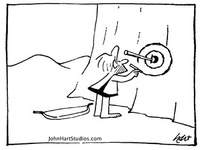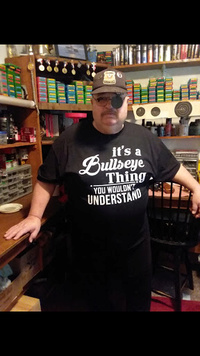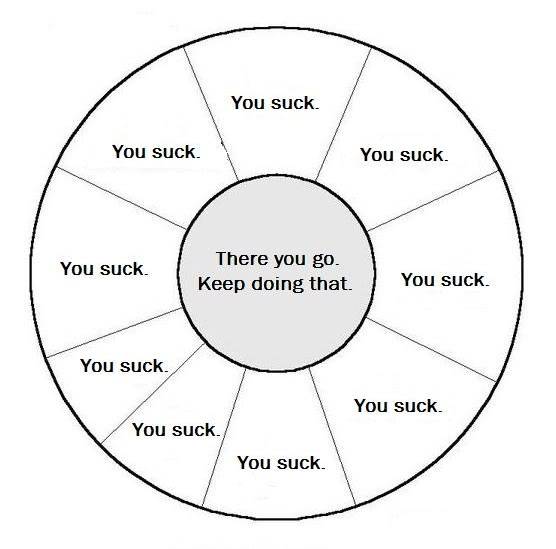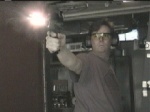Target analysis help
+10
downwardspirals
GrumpyOldMan
SMBeyer
DavidR
kczerwin
BE Mike
LenV
Jack H
Rob Kovach
inthebeech
14 posters
Page 1 of 1
 Target analysis help
Target analysis help
Can you guys help diagnose this symptom? Progression in match is from left to right and group center walks from upper right to lower left very obviously as the time limit shortens. Obviously I'm doing something differently through the stages. I shoot open sights and these are fifty foot matches.
Thanks for the help.
Thanks for the help.

inthebeech- Posts : 614
Join date : 2012-03-17
Age : 58
Location : Harleysville, Pennsylvania
 Re: Target analysis help
Re: Target analysis help
You just need to dry fire more. Once you see good shots in dry fire you will see a difference in the match, and you just have to remember that all that recoil stuff happens after the bullet is gone, and remind yourself that you make hundreds of great shots every day, and this match is no different than making the gun go click at home.
Don't worry about what you did wrong on those targets. Practice doing it right and focus on how good that is.
Don't worry about what you did wrong on those targets. Practice doing it right and focus on how good that is.

Rob Kovach- Admin
- Posts : 2692
Join date : 2011-06-14
Age : 50
Location : Brooklyn, WI
 Re: Target analysis help
Re: Target analysis help
I predict that as you dry fire and your trigger control improves that you will find your group moving up and right even more. Don't forget that those sights have adjustments on them for a reason. If you have a group, adjust to center it--even if you thought everything is dialed in. You never see the sights the same from match to match--adjust if needed.

Rob Kovach- Admin
- Posts : 2692
Join date : 2011-06-14
Age : 50
Location : Brooklyn, WI
 Re: Target analysis help
Re: Target analysis help
Inconsistent gripping can move groups. I have put the gun down reloaded the mag and began again with the group elsewhere
Or after I expanded you picture, you may have been adding some trigger jerk in the sustained targets
Or after I expanded you picture, you may have been adding some trigger jerk in the sustained targets
Last edited by Jack H on Sat Apr 05, 2014 6:20 pm; edited 1 time in total

Jack H- Posts : 2641
Join date : 2011-06-10
Age : 74
Location : Oregon
 Re: Target analysis help
Re: Target analysis help
I agree with Jack that your probably jerking the trigger on sustained fire.I think on the slow fire you are probably anticipating the recoil and pushing your shot.I recognize that upper right group from some of my slow fire groups.As Rob said, more practice dry fire will help both problems.
Len
Len

LenV- Posts : 4684
Join date : 2014-01-24
Age : 74
Location : Oregon
 Re: Target analysis help
Re: Target analysis help
Tight grip = tight group, as long as you can move your trigger independently. Trigger control needs work. In slow fire, keep steady pressure on the trigger. You shouldn't know the split second when the shot will break. Think about following through. When shooting rapid fire, get the first shot off within a second of the target facing. Try to focus on putting pressure on the trigger as you are aligning the sights, not after everything is settled and looking good.

BE Mike- Posts : 2467
Join date : 2011-07-29
Location : Indiana
 Re: Target analysis help
Re: Target analysis help
Google this site: "The Vital Problems of Pistol Shooting Part 2"
Anatoliy Piddubnyy might suggest your wrist is not being held in a rigid position. I used to shoot groups--okay, holes--in those positions just like your targets. I also jerked the trigger. Dry fire has helped a lot. I am now shooting groups. I dry fire using his techniques with respect to firming the wrist and it has really helped.
Anatoliy Piddubnyy might suggest your wrist is not being held in a rigid position. I used to shoot groups--okay, holes--in those positions just like your targets. I also jerked the trigger. Dry fire has helped a lot. I am now shooting groups. I dry fire using his techniques with respect to firming the wrist and it has really helped.
kczerwin- Posts : 22
Join date : 2012-08-30
Location : Central WI
 Re: Target analysis help
Re: Target analysis help
Thanks guys for the ideas. Plenty to work on here.

inthebeech- Posts : 614
Join date : 2012-03-17
Age : 58
Location : Harleysville, Pennsylvania
 Re: Target analysis help
Re: Target analysis help
If im jerking the trigger in the timed stages, shouldnt I be focusing on doing something different in THOSE stages in my training?

inthebeech- Posts : 614
Join date : 2012-03-17
Age : 58
Location : Harleysville, Pennsylvania
 Re: Target analysis help
Re: Target analysis help
inthebeech wrote:If im jerking the trigger in the timed stages, shouldnt I be focusing on doing something different in THOSE stages in my training?
Don't over think it, just keep telling yourself, squeeze, squeeze, squeeze and soon you will break yourself of jerking

DavidR- Admin
- Posts : 3032
Join date : 2011-06-10
Age : 70
Location : NRA:Expert, Georgia
 Re: Target analysis help
Re: Target analysis help
inthebeech,
Your Slow Fire group isn't tight enough either. The dry firing will help all stages. When you disconnect, you expect only a "click" without moving the sights. Practicing with live ammo doesn't do that.
Your Slow Fire group isn't tight enough either. The dry firing will help all stages. When you disconnect, you expect only a "click" without moving the sights. Practicing with live ammo doesn't do that.

Rob Kovach- Admin
- Posts : 2692
Join date : 2011-06-14
Age : 50
Location : Brooklyn, WI
 Re: Target analysis help
Re: Target analysis help
Inthebeech,
Here is what I see and how I would (and did) aproach this. When I first started with the .45 I was having the same problem in rapid fire. My slow was good, timed was good with the exception of the occasional oops, and my rapid was REALLY UGLY!
It looks like you were shooting a .45 and if that's the case more than likely a 1911. What I just started doing with my 45's, after feeling a friends newly installed medium length trigger, is shortening the pull length. I use a trigger shoe because I like the feel and therefore can remove the trigger and grind on it even if it gets into the holes. Then put the shoe back on and see how it feels. Even though I don't have short fingers I found that the standard long trigger that most guns come with was a little long feeleng and was possibly causing me to push the gun a little sideways. That could have been some of it but most was definately me.
I worked on applying pressure on the trigger in sustained fire as soon as I stoped going up with recoil and reset the trigger. Applying more and more pressure to the trigger as the gun is coming down into the aiming area. Remember AIMING AREA!!! It doesn't have to be perfect every time. The 10 ring is actually fairly large if you let it be. Don't just apply pressure when you see an X. A friend of mine likes to tell me X's are just fancy 10's. So what I do in sustained fire is watch the dot with my visual focus ( I know, I know, Zinns doesn't watch the dot but looking at the target REALLY doesn't work for me) but keep my mental focus on the trigger. I watch the dot but don't try to change where it is I just let it go where it is supposed to go on it's own and concentrate on squeeze. Now when you first start working on applying pressure in recoil you are going to get some shots going high and probably off the paper. THIS ISN'T A BAD THING! It proves to yourself that you are applying pressure. A little too much but you are doing what you want to be doing. If you wait to get back to your aiming area before you start applying pressure you are going to feel like it is taking too long to get the shot off then you are going to rush the shot and that is when you jerk it. It doesn't matter if you really aren't running out of time what matters is the feeling of it.
Timed fire is named timed fire. It is not called TIMID fire. You can use the time to your advantage but be sure to be applying ever increasing pressure until the shot breaks. Again AIMING AREA. When you accept the aiming area and squeeze you will see your x count increase without trying to "get" them.
Slow fire is really very similar to timed fire. Accept your hold and let the shot come to you. Don't make it happen, just allow it to happen.
Dry fire. My opinion on dryfire, especially for a begining shooter, is that it can be a double edge sword. It can do as much harm as good. I know there are going to be some of you bash me for that. It can be good for a begining shooter because it really helps with just getting comfortable with the feeling of the gun in your hand. But I also believe that without the feedback of where the shot is going (especially when you are jerking the snot out of it in sustained fire) it can just reinforce the bad habit of the jerk. Until you truly know what it means to break the shot without disturbing the sights you are just going to be reinforcing poor trigger control. Dry fire can be mind numbingly boring and you will find yourself allowing your mental focus to drift. You may not even notice yourself doing this for quite some time. Just going thru the motions of pulling the trigger and thinking about who knows what. This teaches you to allow shots to happen without paying attention to what you are doing. Dry fire can be a useful tool IF it is done correctly but it is not the Holy Grail to better scores. Just because you dry fire does not guarantee you that next classification card.
Scott
Here is what I see and how I would (and did) aproach this. When I first started with the .45 I was having the same problem in rapid fire. My slow was good, timed was good with the exception of the occasional oops, and my rapid was REALLY UGLY!
It looks like you were shooting a .45 and if that's the case more than likely a 1911. What I just started doing with my 45's, after feeling a friends newly installed medium length trigger, is shortening the pull length. I use a trigger shoe because I like the feel and therefore can remove the trigger and grind on it even if it gets into the holes. Then put the shoe back on and see how it feels. Even though I don't have short fingers I found that the standard long trigger that most guns come with was a little long feeleng and was possibly causing me to push the gun a little sideways. That could have been some of it but most was definately me.
I worked on applying pressure on the trigger in sustained fire as soon as I stoped going up with recoil and reset the trigger. Applying more and more pressure to the trigger as the gun is coming down into the aiming area. Remember AIMING AREA!!! It doesn't have to be perfect every time. The 10 ring is actually fairly large if you let it be. Don't just apply pressure when you see an X. A friend of mine likes to tell me X's are just fancy 10's. So what I do in sustained fire is watch the dot with my visual focus ( I know, I know, Zinns doesn't watch the dot but looking at the target REALLY doesn't work for me) but keep my mental focus on the trigger. I watch the dot but don't try to change where it is I just let it go where it is supposed to go on it's own and concentrate on squeeze. Now when you first start working on applying pressure in recoil you are going to get some shots going high and probably off the paper. THIS ISN'T A BAD THING! It proves to yourself that you are applying pressure. A little too much but you are doing what you want to be doing. If you wait to get back to your aiming area before you start applying pressure you are going to feel like it is taking too long to get the shot off then you are going to rush the shot and that is when you jerk it. It doesn't matter if you really aren't running out of time what matters is the feeling of it.
Timed fire is named timed fire. It is not called TIMID fire. You can use the time to your advantage but be sure to be applying ever increasing pressure until the shot breaks. Again AIMING AREA. When you accept the aiming area and squeeze you will see your x count increase without trying to "get" them.
Slow fire is really very similar to timed fire. Accept your hold and let the shot come to you. Don't make it happen, just allow it to happen.
Dry fire. My opinion on dryfire, especially for a begining shooter, is that it can be a double edge sword. It can do as much harm as good. I know there are going to be some of you bash me for that. It can be good for a begining shooter because it really helps with just getting comfortable with the feeling of the gun in your hand. But I also believe that without the feedback of where the shot is going (especially when you are jerking the snot out of it in sustained fire) it can just reinforce the bad habit of the jerk. Until you truly know what it means to break the shot without disturbing the sights you are just going to be reinforcing poor trigger control. Dry fire can be mind numbingly boring and you will find yourself allowing your mental focus to drift. You may not even notice yourself doing this for quite some time. Just going thru the motions of pulling the trigger and thinking about who knows what. This teaches you to allow shots to happen without paying attention to what you are doing. Dry fire can be a useful tool IF it is done correctly but it is not the Holy Grail to better scores. Just because you dry fire does not guarantee you that next classification card.
Scott

SMBeyer- Posts : 375
Join date : 2011-12-07
Age : 52
Location : Southern Illinois
 Re: Target analysis help
Re: Target analysis help
This was very useful Scott. Thanks for taking the time. Last night was another disaster in TF/RF but I do recall being totally surprised on at least two shots out of the four strings of five and since we are only at fifty feet I could see each hit and those two were in the black. Similarly, on the one shot that I recall grabbing when the sight picture was perfect, I wasn't surprised to see this nearly off the paper at nine o'clock. The description of separate tactile and visual foci on trigger and sight picture and the concept of aiming "area" were well-written and will be the objective of quite a few upcomming practice sessions. Thanks again. Ed
Your post should be a Sticky.
Your post should be a Sticky.

inthebeech- Posts : 614
Join date : 2012-03-17
Age : 58
Location : Harleysville, Pennsylvania
 Re: Target analysis help
Re: Target analysis help
It works best for me to have my brain, in non-verbal terms, focused on where the sights are or dot is, on the target, and letting a different part of my mind just sort of automatically squeeze the trigger. Abort if it's really bad, but NEVER force the trigger to try to catch that moment when sight appear to stop in the 10-ring.
My Zen moments come when the gun seems to fire itself when the sights look good.
The key for me is the shot call--if I know where it went, both in direction and how far, it's a shot I can learn from.
My Zen moments come when the gun seems to fire itself when the sights look good.
The key for me is the shot call--if I know where it went, both in direction and how far, it's a shot I can learn from.
GrumpyOldMan- Posts : 482
Join date : 2013-03-08
Location : High Desert Southwest Red Rock Country
 Re: Target analysis help
Re: Target analysis help
Oh, I also BELIEVE in dry-fire. It helped me a lot in the beginning, especially with TF & RF cadence. Used a string on the hammer of the semiauto.
What you are experiencing also begs for ball and dummy drills. Dry fire five times at the range, then randomly put one live round in with two dummies. Dry fire some more. Do whatever mentally is needed to not buck the recoil, paying close attention to how it feels when you expect a click and get a BANG *and* the shot goes exactly on call.
For me, I sort of started to welcome the up and back recoil when I started getting away from bucking the recoil.
What you are experiencing also begs for ball and dummy drills. Dry fire five times at the range, then randomly put one live round in with two dummies. Dry fire some more. Do whatever mentally is needed to not buck the recoil, paying close attention to how it feels when you expect a click and get a BANG *and* the shot goes exactly on call.
For me, I sort of started to welcome the up and back recoil when I started getting away from bucking the recoil.
GrumpyOldMan- Posts : 482
Join date : 2013-03-08
Location : High Desert Southwest Red Rock Country
 Re: Target analysis help
Re: Target analysis help
Exactly what he said, and I'll go into it a bit more. Your hand, through evolution, etc. was built to work as a single unit. This gave us the ability to grip firmly to objects, use tools, etc. Now, you're trying to segregate one finger from the rest of the hand. If your grip isn't tight, it's going to cause sympathetic movement through your hand. You'll see this first in your middle finger, but it can transfer back as far as your forearm. How do you stop it? Occupy, or pre-load those muscles by gripping the pistol tightly. Let's say you have a 5 lb trigger, but you're putting 4 lbs of grip on the pistol. For that last pound, the rest of the hand is going to try to take that extra work, and flex other muscles towards the end of the shot. However, if you grip tight, you're going to have significantly less movement during the trigger squeeze. Next time you snap in, REALLY squeeze it. You're going to see it shake from the tension in your muscles. Then, back off until the shake subsides. Also, applying the grip while the pistol is down, just before you raise your arm, will help you keep that grip tighter without the shake. If you want to see this in action, hold your hand open, fingers slightly spread. Lift a half gallon of water (4 lbs) with your trigger finger. You'll start to see your middle finger taking up some of the slack as well.BE Mike wrote:Tight grip = tight group // Try to focus on putting pressure on the trigger as you are aligning the sights, not after everything is settled and looking good.
Finally, keep the trigger moving. Your trigger squeeze in slow fire should be the same in timed and rapid fire. Your entire course builds to rapid fire. Once the pressure starts, save for an indicator that you should put the pistol down, the trigger keeps moving back.
downwardspirals- Posts : 3
Join date : 2014-04-25
 Re: Target analysis help
Re: Target analysis help
kczerwin wrote:Google this site: "The Vital Problems of Pistol Shooting Part 2"
Anatoliy Piddubnyy might suggest your wrist is not being held in a rigid position. I used to shoot groups--okay, holes--in those positions just like your targets. I also jerked the trigger. Dry fire has helped a lot. I am now shooting groups. I dry fire using his techniques with respect to firming the wrist and it has really helped.
So working on fundamentals, and had a question, from the website,
"An inexperienced shooter cannot stabilize his wrist without tensing his fingers. Since the isolated stabilization is not practiced in daily life, the connections of the nerves between the wrist and the central nervous system have almost faded. Only specific long term training can help one recover these connections"
How do you learn to do this? Thanks again for helping the novice.

JayhawkNavy02- Posts : 821
Join date : 2014-03-01
Age : 45
Location : San Diego
 Re: Target analysis help
Re: Target analysis help
Try this and see how it works for you.Grab an empty plastic bottle with your shooting hand.Now extend your arm like you were shooting a pistol. If your right handed roll you hand and elbow completely to the right like you were trying to empty the bottle. Now just roll your wrist only until the bottle is right side up.You will find your elbow is in a perfect locked position and you have put tension on your wrist.I had you do it with a plastic bottle so you can see how much tension you put on your fingers.I do it this way everytime.Big gun or little when shooting a match.
Len
Len

LenV- Posts : 4684
Join date : 2014-01-24
Age : 74
Location : Oregon
 Re: Target analysis help
Re: Target analysis help
Just to clear up which way to turn arm and wrist. Do You end up with the flat of your inner elbow (where your vein shows) facing up, or inward towards you? I'm asking because if i was emptying a bottle I would turn bottle to the left. Sounds a great idea for locking the wrist but want to make sure i'm doing it right. All the best. Pete.OldMaster64 wrote:Try this and see how it works for you.Grab an empty plastic bottle with your shooting hand.Now extend your arm like you were shooting a pistol. If your right handed roll you hand and elbow completely to the right like you were trying to empty the bottle. Now just roll your wrist only until the bottle is right side up.You will find your elbow is in a perfect locked position and you have put tension on your wrist.I had you do it with a plastic bottle so you can see how much tension you put on your fingers.I do it this way everytime.Big gun or little when shooting a match.
Len
peteswright- Posts : 1
Join date : 2014-04-27
Age : 74
Location : Sheffield. England.
 Re: Target analysis help
Re: Target analysis help
Interesting example and explanation.OldMaster64 wrote:Try this and see how it works for you.Grab an empty plastic bottle with your shooting hand.Now extend your arm like you were shooting a pistol. If your right handed roll you hand and elbow completely to the right like you were trying to empty the bottle. Now just roll your wrist only until the bottle is right side up.You will find your elbow is in a perfect locked position and you have put tension on your wrist.I had you do it with a plastic bottle so you can see how much tension you put on your fingers.I do it this way everytime.Big gun or little when shooting a match.
Len
I'm trying it with 12 OZ'rs lol

james r chapman- Admin
- Posts : 6087
Join date : 2012-01-31
Age : 75
Location : HELL, Michigan
 Re: Target analysis help
Re: Target analysis help
Yes,you end up with the flat of your elbow up.It should end up slightly twisted to the right if your right handed.You can really feel your elbow lock if you do it this way.
Len
Len

LenV- Posts : 4684
Join date : 2014-01-24
Age : 74
Location : Oregon
 Re: Target analysis help
Re: Target analysis help
Locking your elbow is a recipe for tennis elbow. The repeated shock of shooting a .45 for an extended period may lead to damage to your elbow if you do this.OldMaster64 wrote:Try this and see how it works for you.Grab an empty plastic bottle with your shooting hand.Now extend your arm like you were shooting a pistol. If your right handed roll you hand and elbow completely to the right like you were trying to empty the bottle. Now just roll your wrist only until the bottle is right side up.You will find your elbow is in a perfect locked position and you have put tension on your wrist.I had you do it with a plastic bottle so you can see how much tension you put on your fingers.I do it this way everytime.Big gun or little when shooting a match.
Len
I don't lock my elbow and have done pretty well. Brian Zins also does not either.
There is no way to 'lock' your wrist either. There are too many bones (
Over or under tightening the grip will lead to shake or inconsistent recoil control. The grip needs to be firm like a good handshake.
When I am in a groove in timed and rapid fire, 90% of my focus is on the sights while the trigger pull is an after thought taking up the remaining portion of my concentration. Slow and steady wins the race.
Lots of dry firing will train your subconscious mind to pull the trigger leaving your conscious mind to focus on the sights.
Weight training will improve grip and shoulder strength helping to reduce the wobble.
Mental training will help you remain calm and avoid anxiety during timed and rapid fire. The book "With Winning in Mind" makes for an easy and helpful read.
Finally... keep a sense of humor and have fun. Here is a chart I like to refer to people who like charts.


bdutton- Posts : 121
Join date : 2012-08-22
 Re: Target analysis help
Re: Target analysis help
So if you don't lock your elbow is there a grip or other technique you use for consistently gripping the gun ? , the zins grip doesn't work for me and at least two nat.champs I asked don't use it either,

DavidR- Admin
- Posts : 3032
Join date : 2011-06-10
Age : 70
Location : NRA:Expert, Georgia
 Re: Target analysis help
Re: Target analysis help
Basically... grip the gun with the web of the thumb high as possible. Put arm straight and lift up. If using a dot, the dot should line up in the center of the tube without having to bend the wrist to 'find' the dot. If its not centered, adjust the grip until it is properly lined up using the same procedure above, slightly rotating the gun in the direction it needs to go to have proper alignment.DavidR wrote:So if you don't lock your elbow is there a grip or other technique you use for consistently gripping the gun ? , the zins grip doesn't work for me and at least two nat.champs I asked don't use it either,
It helps too to have a way to remember exactly where the grip should be every time. Some people build up the grip with putty so that the meat of the hand is in contact all the way up and down the grip. You can also try using a reminder like extending your trigger finger out to the trigger guard and remember how much of the finger extends beyond the trigger guard when it fits right.
Same basic idea with iron sights. The front post should align evenly between the rear sight gap. If not, adjust until it does.

bdutton- Posts : 121
Join date : 2012-08-22
 Similar topics
Similar topics» Browning Buck Mark Field Target vs. Ruger Mk IV Target?
» 6" Pardini + 1st RF Target + Target w/Horton grips
» New (for me) target .22
» Used target 22's
» Best target ever
» 6" Pardini + 1st RF Target + Target w/Horton grips
» New (for me) target .22
» Used target 22's
» Best target ever
Page 1 of 1
Permissions in this forum:
You cannot reply to topics in this forum